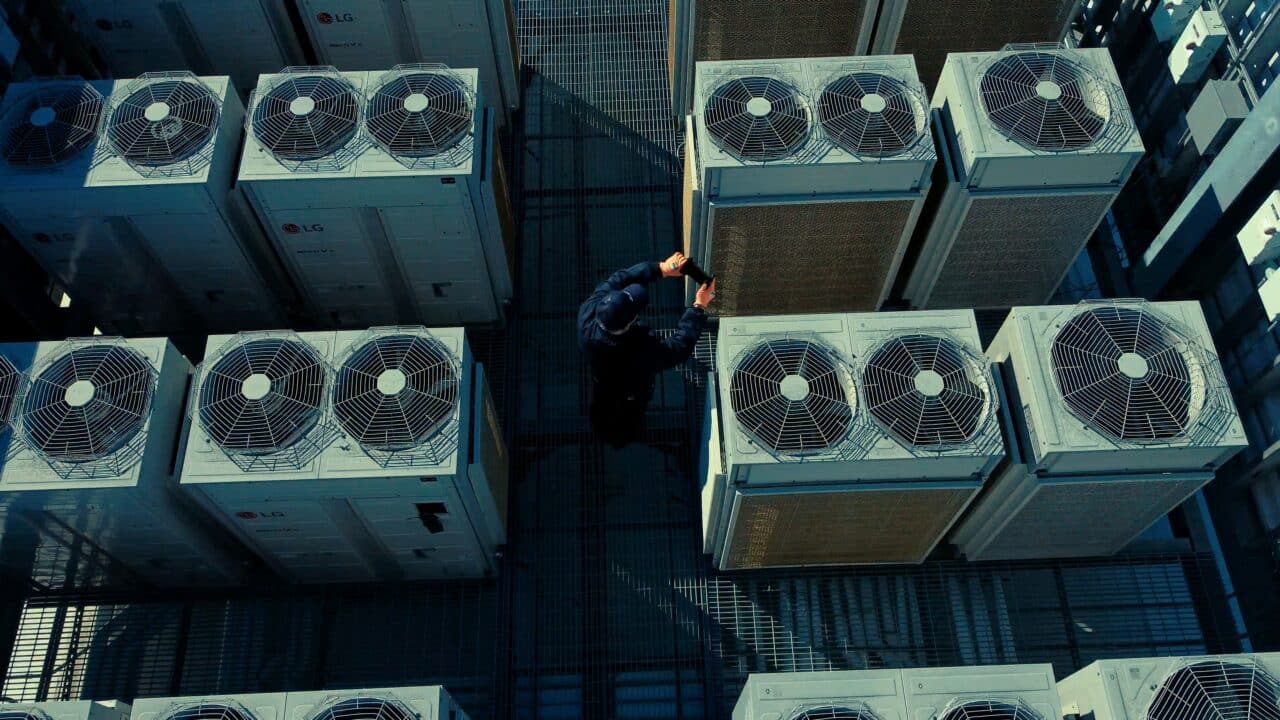Employee productivity and customer satisfaction are two of the most important factors in any successful business. The key to achieving both? A reliable and efficient Heating, Ventilation, and Air Conditioning (HVAC) system.
But a poorly maintained or inadequate HVAC system can increase costs, reduce energy efficiency, and negatively affect indoor conditions for offices, hotels, retail spaces, and other commercial properties. This quickly leads to disgruntled employees and customers…
Let’s explore the tangible benefits of investing in professional HVAC maintenance for commercial buildings and how a preventative maintenance plan can optimize operations and maximize cost savings.
Overview of Commercial HVAC Systems
HVAC systems aren’t one-size-fits-all, and commercial buildings have different requirements for temperature, humidity, ventilation, pressure, and even smoke extraction, which makes them very different from residential systems.
Depending on the size of your property, the type of building, the day-to-day operations of the building, and other factors, your building will require a specific system to meet the demands of its occupants.
Here’s a quick overview of commercial HVAC systems:
Single-split systems
Single-split systems consist of a single indoor unit and a single outdoor unit, which are connected by refrigerant piping. These systems are typically used in small commercial spaces like offices or retail stores.
Benefits
- Affordable
- Can be used for heating and cooling
- Ideal for buildings with multiple small rooms
- Allows individual room control
- Independent functioning of each system
Drawbacks
- Requires substantial outdoor space for multiple units
Rooftop units
These are self-contained HVAC systems that are mounted on the roof of a building. They contain all the heating and cooling system components in a single unit and are commonly used in larger commercial buildings.
Benefits
- More energy efficient than single-split systems
- Low noise levels
- Modular design allows for easy expansion or replacement of parts
- Allows central control of multiple units
- Lower operational costs due to more efficient operation
Drawbacks
- Expensive installation and maintenance costs
Packaged Units
Packaged units are similar to rooftop units in that they are self-contained HVAC systems designed for commercial use. However, packaged units are typically installed on the ground rather than on the roof.
Benefits
- Compact design allows for easy installation
- Lower maintenance costs due to fewer components
- Ability to combine multiple functions (heating, cooling, ventilation) into one unit
- Can accommodate large-scale installations with multiple units
- Low noise levels
Drawbacks
- Expensive upfront cost
VRF/VRV systems
Variable refrigerant flow (VRF) or variable refrigerant volume (VRV) systems are advanced commercial HVAC systems linking multiple indoor units to one outdoor unit, allowing for individualized temperature control in different building zones.
Benefits
- Personalized heating and cooling across multiple zones
- More powerful and suited for larger facilities
- Multi-zone operation
Drawbacks
- More expensive installation costs
- Higher operational costs
Multi-split systems
In a multi-split system, multiple indoor units connect to a single outdoor unit, requiring less outdoor space and offering better control over indoor units. These systems are typically used in larger commercial buildings with greater distance between outdoor and indoor units.
Benefits
- Connects up to ten indoor units to one outdoor unit
- Inverter technology allows individual settings for each unit
Drawbacks
- Higher installation costs
- Requires more pipework
Each commercial HVAC system has unique features and benefits, making it suitable for different commercial buildings. But overall, if you’re purchasing a new HVAC system for your commercial building, the most important factor to consider is the size of your property and the type of operations it requires.
The Benefits of Regular HVAC Maintenance
Businesses are always looking for ways to cut costs — an understandable decision, especially in times of recession. But overlooking regular HVAC maintenance can actually cost you more in the long run. Here’s why:
Energy Efficiency and Cost Savings
One of the most compelling reasons to maintain commercial HVAC systems regularly is the potential for energy efficiency improvements and cost savings. According to the U.S. Department of Energy, proper HVAC maintenance can save businesses 5 to 20% on annual energy costs, depending on the system and building type. And since energy costs are the largest operating cost for most commercial facilities, this can add up quickly.
Enhanced System Performance and Longevity
Regularly maintained HVAC systems operate more efficiently and are less likely to experience unexpected breakdowns. The American Society of Heating, Refrigerating, and Air-Conditioning Engineers (ASHRAE) estimates that HVAC equipment lasts anywhere from 15 to 20 years, depending on the system and its maintenance.
But much of that comes down to individual components. Some components can last as long as 35 years, and universal parts are available for purchase in case repairs or replacements are needed. Certain components may not require replacement, while others, like compressors, might need to be changed more than once.
Although your commercial HVAC system may still be in perfect working condition after 20 years, it is essential to practice regular maintenance to maximize its lifespan and performance. With the right care, your HVAC system can remain functional beyond the manufacturer’s expectations for many years.
Improved Indoor Air Quality for Businesses
Maintaining a healthy indoor environment is essential in business, especially for those relying on physical labor or serving many customers daily. The air inside commercial buildings is circulated multiple times per hour, making it all the more important to ensure it’s clean and safe for everyone indoors.
Here’s some shocking research to consider about indoor air quality and the workplace:
- Data from the EPA shows that Americans spend a whopping 90% of their time indoors, much of it in an office setting.
- Indoor air can be up to 5x more polluted than outdoor air and sometimes up to 100x higher!
- Studies conducted in 2021 uncovered poor indoor air quality decreases productivity and cognitive function.
- Indoor air pollutants are responsible for 4% of diseases worldwide, including cardiovascular conditions such as heart disease, pneumonia, stroke; diabetes; and even lung cancer.
Even if your building is brand new or recently remodeled, you’re still unsafe from the dangers of poor indoor air quality. In fact, research has indicated that up to 30% of newly built commercial structures can experience high levels of occupant complaints related to health and comfort — all stemming from indoor air quality.
So if you’ve been dealing with seemingly endless employee sick days, the culprit may be your HVAC system!
Regulatory Compliance
In many jurisdictions, businesses must meet specific HVAC standards to comply with building codes, energy efficiency regulations, and environmental policies. This is usually relevant for new construction or remodeling projects but can also apply to existing buildings.
Regular maintenance can help organizations stay compliant and avoid fines, penalties, or legal issues.
Reduced Repair Costs
No surprise here — proactive maintenance will reduce repair costs. By staying on top of problems and conducting regular inspections, facility managers can detect issues before they become too costly to manage. This is especially true if your HVAC system is older or hasn’t been serviced.
But the cost savings don’t stop at repairs. Regular maintenance can also help businesses save on energy bills, as inefficient systems tend to use more electricity than necessary.
Increased Comfort
Negative Yelp reviews, employee turnover, and a decrease in revenue can all be related to poor building conditions.
People are more productive when comfortable and can focus on their work without worrying about hot or cold spots, loud noises, or worse — constant illness. And customer satisfaction is strongly tied to customer comfort as well.
In the hospitality industry, customer satisfaction highly depends on a comfortable atmosphere conducive to relaxation and leisure. The same goes for offices, schools, retail stores, and other commercial spaces — the key to success lies in creating an inviting atmosphere that keeps people coming back, and a major part of this is having a well-functioning HVAC system.
HVAC maintenance can ensure that indoor temperatures are consistently comfortable throughout the year, so everyone in the building can be as productive and comfortable as possible.
Potential Safety Risks Associated with Poor HVAC Maintenance
We’ve already discussed some health risks related to poor indoor air quality, but let’s dig in deeper because your facility’s HVAC system can also lead to major safety risks if not maintained properly. And you don’t want to be liable for any accidental injury or death related to malfunctioning HVAC equipment.
Neglecting HVAC maintenance can lead to a variety of safety risks:
- Carbon Monoxide Poisoning: A lack of proper maintenance for gas furnaces and boilers can lead to unsafe levels of carbon monoxide. This colorless, odorless gas poses a significant health risk to building occupants, with 100,000+ people in the US visiting emergency rooms yearly due to accidental poisoning.
- Fire Hazards: Dust and debris buildup in HVAC systems can heighten fire risk, especially with electrical issues. In fact, heating systems account for up to 15% of commercial building fires in the US.
- Mold and Mildew Growth: Inadequate ventilation and humidity control can lead to mold and mildew growth in commercial spaces, contributing to poor indoor air quality and potential health issues.
- Smoke Exhaust Issues: An improperly maintained HVAC system may struggle to vent smoke and other hazardous materials correctly, posing a serious concern for commercial kitchens, industrial facilities, and spaces where smoke, gas, or other dangerous substances are generated.
How Often Should Commercial HVAC Systems Be Maintained?
As a business owner or facility manager, you’re likely looking to keep costs low and minimize disruptions to your operations. So how often should you maintain your commercial HVAC system to strike that perfect balance?
The ideal commercial HVAC maintenance schedule varies depending on the type of equipment, the needs of the building or facility, and how often it’s used. In general, though, most systems should be checked at least twice yearly – once in the spring and again in the fall – to ensure they’re running efficiently and safely.
Additional maintenance may be necessary for buildings with high-usage commercial HVAC systems to prevent unexpected breakdowns and major repairs.
Commercial HVAC Preventative Maintenance Checklist
Okay, we’ve established that a reliable and efficient HVAC system keeps occupants comfortable and healthy and helps maintain productivity and profitability. But maintaining such a complex system can be challenging, especially when juggling countless other responsibilities. That’s why it’s important to understand what regular maintenance can include for your individual facility. Having a skilled team of HVAC professionals in your corner is also important.
An experienced commercial HVAC technician will be familiar with the common issues for your specific model. They’ll follow a commercial HVAC preventative maintenance checklist, which should address the following:
- Swapping out or cleaning air filters ensures smooth airflow and prevents dust and pollutants from building up in the system.
- Monitoring refrigerant levels, making sure they’re just right for effective cooling.
- Securing electrical components and inspecting wiring to avoid any hazards or shorts.
- Checking all ductwork for leaks or blockages that might affect airflow or waste energy.
- Taking a close look at motors, belts, fans, and other moving parts to ward off unexpected breakdowns.
- Assessing the system’s thermostat and calibrating it for consistent temperature and efficiency.
- Inspecting condensate pumps to guarantee proper drainage and prevent property damage.
- Cleaning the condenser and evaporator coils for better energy efficiency and reduced noise pollution.
- Confirming the system is connected to a suitable power supply for safe operation.
- Carrying out a comprehensive safety inspection to protect against potential hazards.
By staying on top of this checklist, you can keep costs low, minimize interruptions to your business, and ensure your HVAC system runs smoothly for years to come.
Lee Company offers comprehensive, cost-effective solutions tailored to the unique needs of commercial facilities throughout Tennessee. From customized maintenance plans to 24/7 emergency service, our experienced technicians can help you keep business operations running smoothly. Learn more about our Facility Solutions here.
Interested in commercial HVAC maintenance?
CALL US NOW AT 615.567.1000

